

A well-produced theater performance tells a story that an audience connects with, but none of this magic comes to life on its own. It takes dozens of people working behind the scenes to prepare for opening night, including AVL technicians. The AVL crew includes anyone who works on the audio, visual and lighting side of the production. Their hard work impacts nearly every area of performance.
For example, audio technicians use their deep understanding of sound to bring scenes to life with music or special effects. They also directly impact how well the audience can hear the production and often deliver audible cues for performers during a scene. Lighting adds emotion and drama to the stage, establishing a stronger sense of place and helping the performers put on a more believable production. Visual technology, including rigging and drapery, is a way of communicating with the audience. It also lets performers and crew know where to be and when to be there.
To get a better idea of the work that goes into a dramatic production, let’s review some common AVL and theatrical terms.
A lot goes into a theater production to get ready for opening night. Here are some commonly used theater stage terms you might hear as you prepare for an upcoming performance:
The batten is a bar made of pipes, steel or wood that extends horizontally across a wall of the set, either upstage or downstage. This is where you hang decorations, props and some types of lighting for a scene. You can also use a batten to reinforce flats.
A black box is an area on the stage, usually a four-walled room, with no strict set pieces, props or assigned areas. Everything is usually painted black. The idea is to reconfigure the black box to suit scene needs with lighting and changing props. Some theaters, known as black box theaters, specialize in black-box-only productions.

A cue is any audible or visual signal given to or from technical departments to initiate a certain effect. Sound cues are known as SQ, while visual cues are called Vis. The act of giving someone a cue is “cueing.”
All technicians should be careful to avoid “death by cues,” a phrase used to indicate too many excessive and unnecessary cues at once. You can often find a list of existing technical cues in your venue or organization’s prompt book. Performers are also given their own set of cues by their stage director.
A field check is when you or a professional visits a potential project site to learn more about it, including measurements, concerns and available seating.
The International Building Code, or IBC, is a set of international public health and safety standards that all theaters must abide by when installing and managing audio, visuals, lighting, props and pyrotechnics.
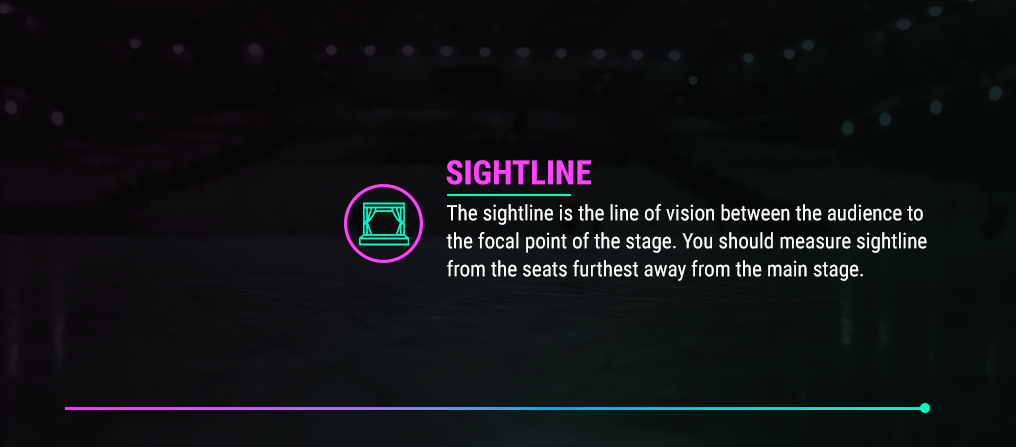
The sightline is the line of vision between the audience to the focal point of the stage. You should measure sightline from the seats furthest away from the main stage. Once measured, mark the sightline in the wings on either side of the stage so actors and technicians know where to stand to remain unseen.
From music and sound effects to microphone clarity and acoustics, no production is complete without crisp, clear audio. If you’re new to the world of stage production audio, here are some basic terms you should know:
Though you can use “amp” to refer to “amperes” — a measurement of electric currents — in the theater, it usually refers to an amplifier. Amplifiers are a type of sound equipment that allows you to boost a low-voltage audio signal at your sound platform and translate it to a higher current that is more suitable for your output speakers.
The automatic gain control, or AGC, is a setting built in to recording equipment that automatically adjusts sound input for differing volumes, creating a consistent, level sound and volume.

To attenuate a sound is to reduce how intense that sound signal is by lowering the amount of energy produced. Most sound desks have a built-in attenuation switch, often labeled as “PAD.”
When an amplifier or sound mixer gets overwhelmed with too much sound, it enters a type of overdrive. When this happens, it produces an audio clipping that manifests as distorted audio.
Decibel, or dB, is a unit of measurement for audio volume. The less dB a sound has, the more difficult it is to hear and vice versa. A 0 dB measurement is almost entirely silent, while sounds 85 dB and higher can be dangerous.
Equalization is when you adjust sound frequency to create a more “normal” tone. There are several levels of sound frequency to adjust, but treble and bass are the most common and encompass a wide range of smaller frequencies.
If you’ve ever heard an ear-piercing whistle or low rumbling sound around your microphones or sound system, you’ve heard sound feedback. Feedback happens when sound gets amplified too many times, either due to incorrect microphone placement or damaged equipment. You can combat feedback by investing in an omnidirectional mic, equalizing the sound signal or lowering speaker output.
An audio jack, or audio connector, is how you attach an audio source to a piece of equipment. There are different types of audio jacks, depending on the equipment and type of audio input device you’re using. Connectors can be male or female and work with either input or output audio.
The mixer — known as the “sound desk” or “soundboard” — is the station where an AVL technician manages sound input and output. This is also where you’ll use audio features, like equalization, to optimize and adjust frequencies, levels and volume. Some mixers have a built-in amplifier.
“Noises off” is a phrase used in the theater to quiet any unwanted noise offstage, like cellphones, voices and other commotion.
In a theater setting, pick-up usually refers to the relationship between a microphone and its directional sound input. A microphone can pick up noise from the front, back and sides. Different microphones are designed for specific directional pick-up, like an omnidirectional mic, which picks up sound from all around it.
Sound reverberation, or reverb, is a special digital effect that prolongs a sound and gives it a sense of depth by pushing it against more surfaces in the room.
In the theater, a sound check is when an audio technician tests each component of an audio system to make sure everything works correctly and sounds good. You will likely perform multiple sound checks, including before dress rehearsals and before each production.
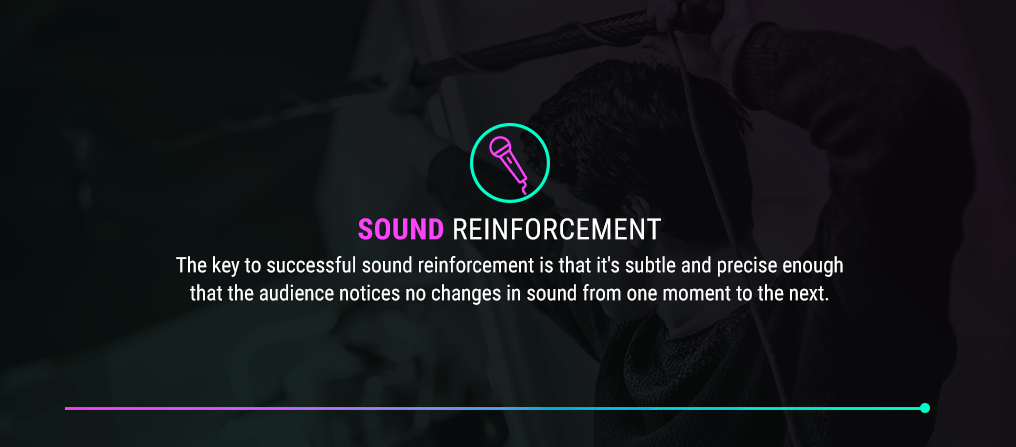
To reinforce a sound, particularly a voice, is to adjust the level of amplification for optimal audience listening. The key to successful sound reinforcement is that it’s subtle and precise enough that the audience notices no changes in sound from one moment to the next.
Variable acoustic curtains absorb unwanted sound around the auditorium. You can adjust them to fit needs between scenes.
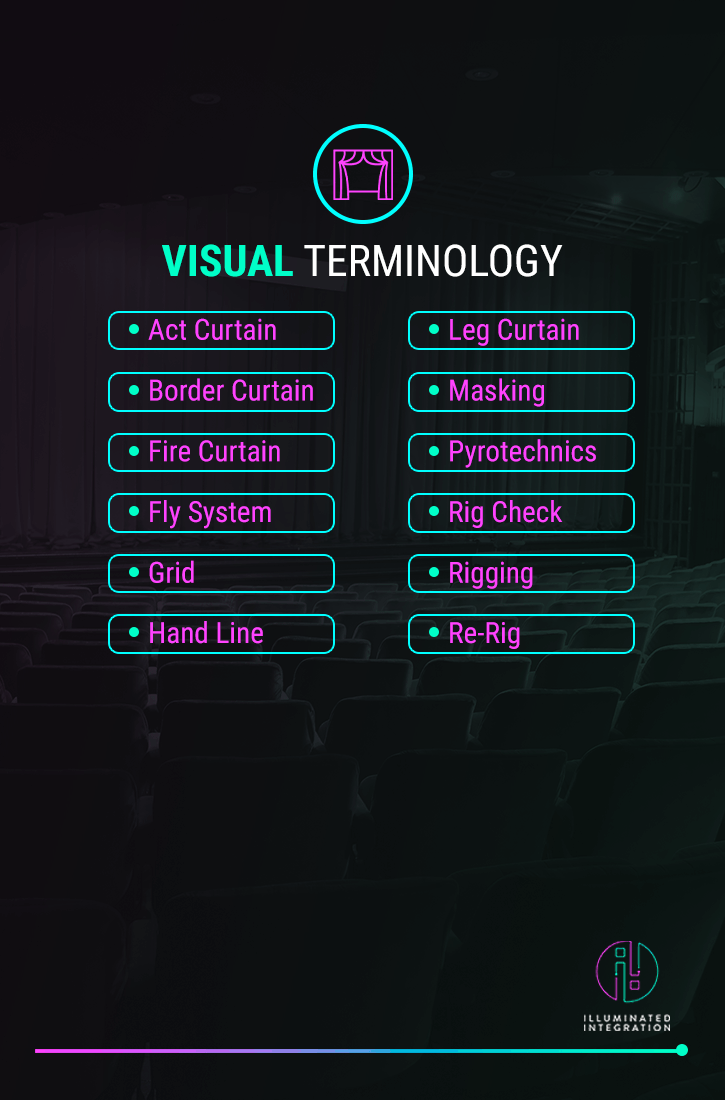
While the audience is focused on the on-stage performers, those behind the curtains make sure the audience can concentrate without interruption. Curtain placements, rigging and directions are all crucial elements of production. Here are some important visual words to know, including some stage lighting vocabulary and stage rigging terms:
The act curtain has many names. You might have heard it called the front curtain, house curtain, main act curtain, main curtain, grand drape or proscenium curtain. Regardless of how your theater labels it, it refers to the primary curtain used in a proscenium theater.
A border curtain is a masking piece you stretch horizontally across the top of the stage to define an upper limit for the scene while also hiding lighting, rigs, scenery and unused props from the audience’s sightline. While it’s common to choose neutral colors for your border curtain, you might also decorate them according to your production, like a blue sky with clouds or a city skyline.
A fire curtain hangs around the perimeter of the stage to protect an audience from a fire, if one occurs during a show. Most close automatically and protect against heat, flames and smoke. Some fire curtains have smoke pocket slots that add additional smoke filtration. It’s important to note that fire curtains do not eliminate the need for a proper fire alarm system and functional, up-to-date extinguishers.
A fly system, also known as the “flies,” is a mechanical system that lets you move battens and tabs — which hold the scenery, lights, drapery and more — via electrical winches and counterweights. You might also use a fly system to move a person or prop into the air for some productions.
The theater definition of grid, or gridiron, is a support system of structures — usually made of steel or wood — located in the upper portion of the room, near the roof. This is where you’ll mount equipment, rigging, some lighting, pulleys and fly systems. When mentioned in conjunction with fly systems, “gridded” means something has “flown” as high as it can without entering the grid.
The hand line is a rope or cord that you manually move to control or transfer a load.
A leg curtain defines the sides of a staging area near the wings and masks unused props, extras, crew and equipment. They are usually neutral in color.
To mask something in the theater is to hide or secure it out of the audience’s sightline, usually with curtains. Masking also helps establish clear boundaries for the scene. Masking style varies between productions. You can either mask something to blend in via a neutral-colored curtain, or use masking curtains to enhance the setting.
Pyrotechnics are flammable or explosive effects used in some types of productions. They can include smoke, fireworks, loud noises and flashing lights. Though specific rules vary from location and venue, you typically need to have a professional, licensed pyrotechnician to use them in a show.
The rig check is when the professional in charge of lights and rigging inspects all rigs for functionality. This needs to be done regularly and in plenty of time to make replacements or repairs before the show begins.
Rigging refers to the ropes, wires, pulleys, weights, hardware and other items used to control curtains and props. Every rigging system relies on a specific type of balance and weights. The first thing you’ll learn when studying stage rigging basics is how to adjust and manage this counterweight system. The more intricate and advanced your rigging is, the more special effects you’re able to add and control in your performance.
To re-rig a lighting arrangement is to adjust it between performances or scenes.
Lighting is an essential part of the show, even before a performance starts. It lets an audience know where to look, shows performers where to stand and adds emotion and story to each scene. Those working in AVL need to have a clear understanding of shadows, colors and brightness, including how each element works together. Here are a few helpful lighting terms to know:
Accent lighting is a specialized light meant to enhance a particular prop, location or performer during a production. This can be for stylistic or story reasons, or it can be a practical way to let the audience know where to look or what cues to notice during a scene. You can make a light into an accent light by adjusting the color, intensity or brightness.
An aerial gobo is a movable light that creates a sense of atmosphere above the stage or audience, usually used alongside theatrical smoke effects.
Ambient light is the lack of stage lighting in an area or the natural background light. You can either mask it, manipulate it or integrate it into your production.
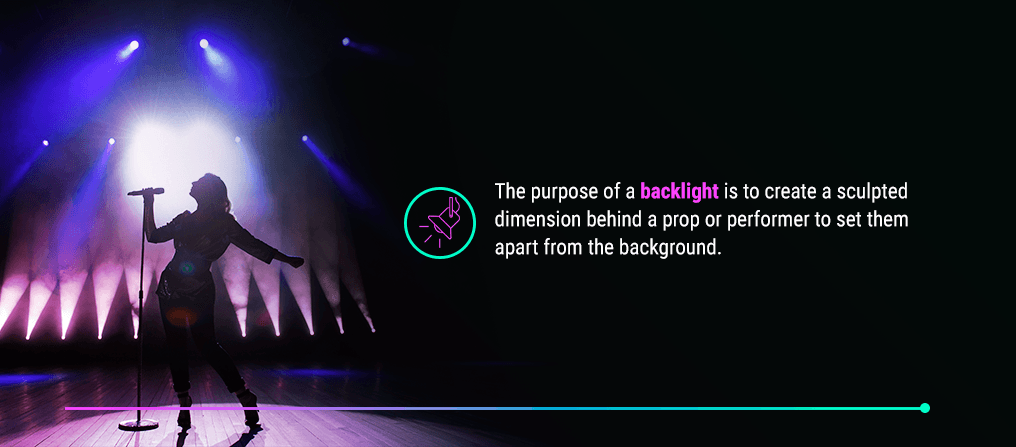
The purpose of a backlight is to create a sculpted dimension behind a prop or performer to set them apart from the background. You can adjust your backlight’s angle and intensity to be very noticeable or have a more subtle halo effect. You can also use a backlight to establish a sense of depth on a set.
The beam light is a floodlight fixture without a lens that creates an intense beam of light. It’s also known as a beam projector.
Blinders are a special diffusing light you arrange in your staging area to mask the stage during scene changes.
In terms of lighting, the boom is a vertically mounted light or arm, usually located near the rear or downstage of the proscenium area. You can use a boom to create side light across the stage.
Bounce refers to the action of diffusing light between curtain calls via blinder. Audio technicians also use the term when mixing separate audio tracks into a single track.
A lighting chase sequence is when you repeat a sequence of light changes — patterned or randomized — to complement a song, scene or moment on stage. You set and control a chase sequence from the lighting desk. When done correctly, a chase sequence looks as if the lights themselves are moving around the stage.
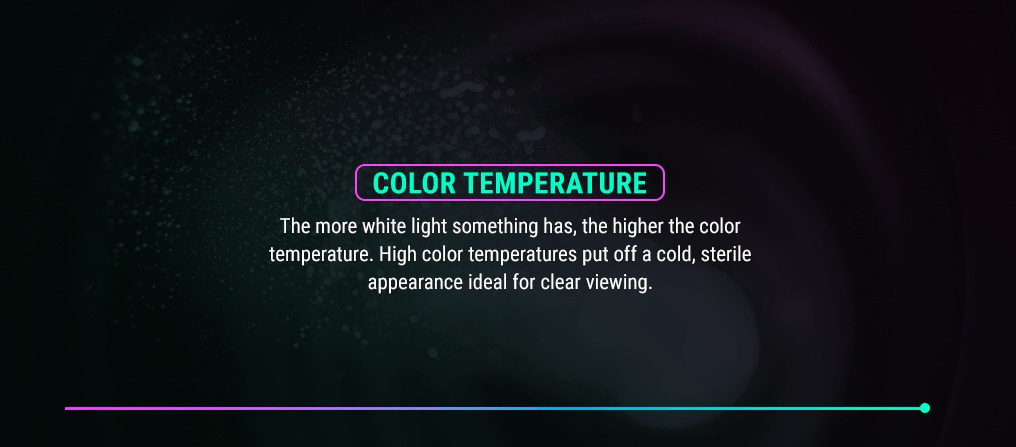
Color temperature is the measurement of white light in a particular lamp, room or scene. It’s measured in degrees Kelvin. The more white light something has, the higher the color temperature. High color temperatures put off a cold, sterile appearance ideal for clear viewing. White light doesn’t always look white — sometimes it appears as a blue tint.
Low color temperatures, or lights and settings with less white, will look warmer or softer. To get a better idea of color temperature, think of the difference between flickering, golden candlelight or a smoldering fire compared to a stark hospital room or a bright, sunny day outdoors.
To cross-fade lighting is to bring new lighting in while slowly dimming or removing the other lighting to create a gradual, faded transition. You can do this manually or through a pre-programmed lighting setup at your lighting desk. In audio, cross-fade means the same thing, but with sound effects or music. You use cross-fades to show movement from one setting to another within a scene or to indicate the passing of time.
Flagging is when you move your hand in front of a light beam to find its location on the stage. Though not always necessary, it’s a fast way to find your lighting on large sets with intricate lighting setups.
Floor lights are mounted at stage level to create uplight and shadows on the stage and performers.
A lighting plan or lighting plot is the preparations you make before production in terms of lighting design and placement. Lighting plans are crucial, especially for shows using many types of lighting. When designing a lighting plan, you note each lamp and fixture’s exact location, including all necessary information about that light, like position, intensity and color. A professional AVL technician can help you create an efficient, safe lighting plan for your production.
The throw refers to the distance between a light and the item it’s lighting, like a prop or performer. Always account for throw when designing your lighting plan.
Having a strong understanding of lighting, sound and visual effects is an essential part of a successful stage production. The more you know about the technical side of your show, the more you’re able to bring your story to life and entertain your audience.
Avoid using pre-designed AVL setups. Every venue, stage and performance is different, so your audio, visuals and lighting should also change. Though pre-designed setups might seem like a fast solution, they can hurt your performance and leave your audience and stakeholders disappointed. Instead, opt for a personalized AVL setup that suits every space and performance’s unique needs.
At Illuminated Integration, we can help you create an unforgettable experience for your audience through custom AVL services for theaters, including:
Each of our AVL consultants is dedicated to helping you transform your production and has years of experience across various venue types and sizes. Contact us to learn more about our theater services today.